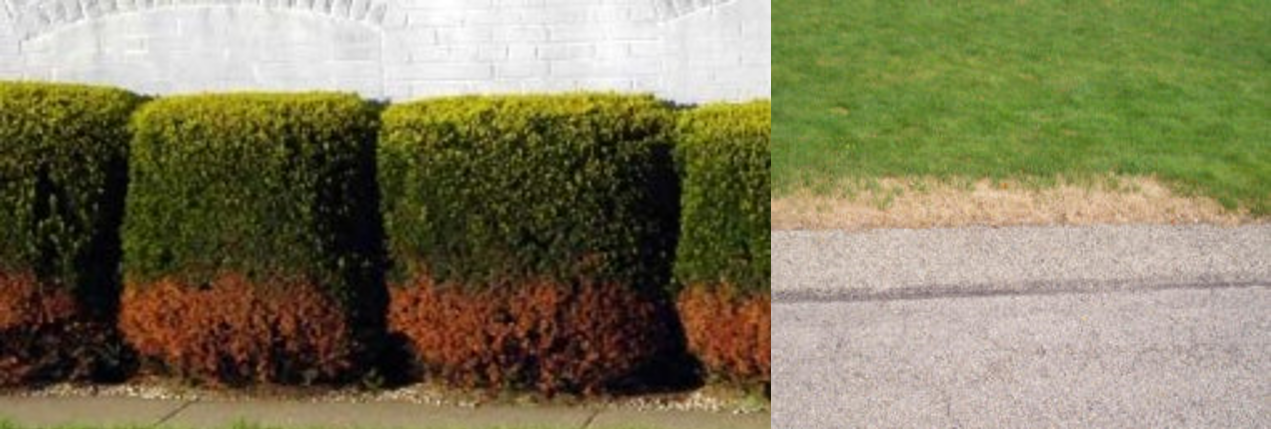
'Tis the Season For Salt...
As we wrap up our winter and prepare for spring, our attention turns to green grass and blooming flowers. Spring signals the season of regrowth and rejuvenation, but it can also pose many issues and problems left over from the winter. One of those problems is salt damage. Despite the necessity of using salt melt to keep us safe, there are downsides to its’ use as well! It’s use can be extremely damaging to turf and landscape plants. Salt granules will move off pavement to turf areas and landscape beds, where it dissolves and saturates the soil. This extremely concentrated saltwater dries out roots and makes the soil toxic to plants. Salt damage can also occur on bushes and shrubs when the foliage of these plants is covered in salt or salt water.
Salt-damaged turf and landscape plants damaged by salt show many of the same symptoms. In all cases of salt damage, moisture is lost from the plant or the soil. Salt absorbs incredible amounts of water, and the result is a plant leaf or soil that has had a great amount of moisture removed. That moisture is essential for plant health, so the effects are extremely detrimental! Salt-damaged turf is usually yellow/brown, accompanied by the turf having a very “crunchy” texture. Leaf edges on trees & shrubs will be discolored with curled/deformed edges.
Can Salt Damage be "Fixed"?
To a certain extent, yes. However, that extent usually isn’t known until late spring when plants have recovered from winter dormancy and are fully growing. Light salt damage will go away once spring rains begin, and salt is flushed from the soil. If salt damage is suspected, one could spray down the foliage of exposed plants, and saturate the soil to speed up this flushing process. New growth emerges and the damaged plant material falls or is mowed off. On slow-growing plants, this damage may take a few years to grow out, and be properly pruned off. However, part of that strategy being effective is making sure that no further salt damage is done (we’ll touch on that later). In our part of the country, where copious amounts of salt may be used in a bad winter season, the damage may not be so light. Plants may need to be replaced, and turf areas will require new seed or sod. Once the dead/damaged plant material is removed, new soil will need to be added in its place. In order to make sure salts are out of the soil, it is recommended that gypsum is applied. Gypsum contains calcium and sulfur, which help to counter the effects of salt. It is a good maintenance practice to apply gypsum in the spring and fall to areas where salt damage may occur, as building up calcium and sulfur in the soil will help mitigate further damage.
Can Salt Damage be prevented?
In a word, yes! In some instances, using ice melt products is unavoidable. The good news is that there are products available that are much safer to use around plants and turf. Our “typical” ice melt is made of sodium chloride. It’s inexpensive and effective, making it the most-used product. However, it is not kind to plants and can even corrode concrete and stone over time. Magnesium chloride is much safer to use around plants and turf, but is more expensive and can be hard on certain flowers. It is a great option, as it is moderately priced compared to some other ice melt products while being gentle to most plants. Calcium chloride is a product that is effective at VERY low temperatures, and while it isn’t completely safe to plants, is a better option than sodium chloride. Potassium chloride is safe to use on plants but the cost of raw materials has risen over the last few years making this an expensive product to use. There are a few different Acetate products (containing calcium, magnesium, sodium and potassium) that are “as corrosive as tapwater”, making them the safest products to use for plants, pets, and hard surfaces. Acetate products are used on airport runways and other critical areas where performance is paramount, but they are the most expensive products available.
While it probably isn’t feasible to treat our properties like an airport runway, plant damage can be avoided by using plant-safe products where necessary. The added cost for the right product is worth it, if it means saving time and avoiding the cost of replacing turf and landscape plants.


No comment yet, add your voice below!